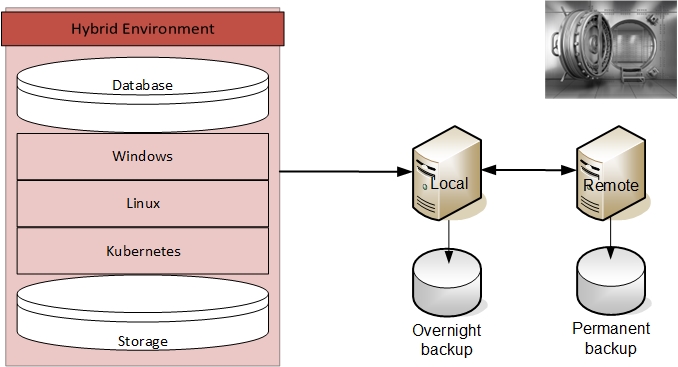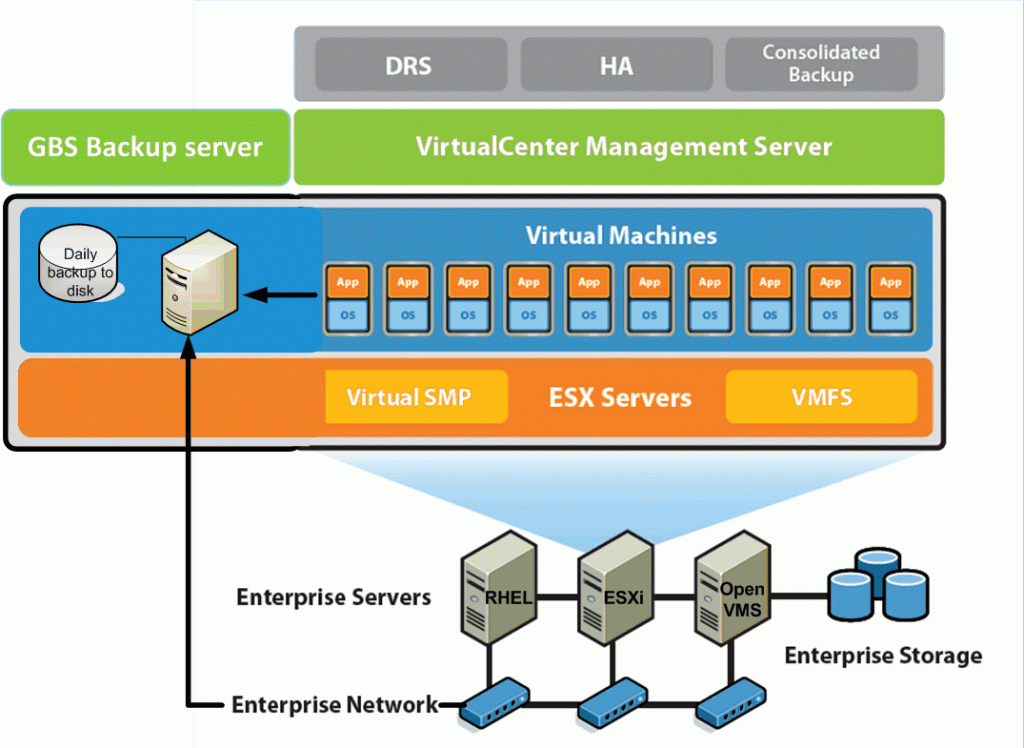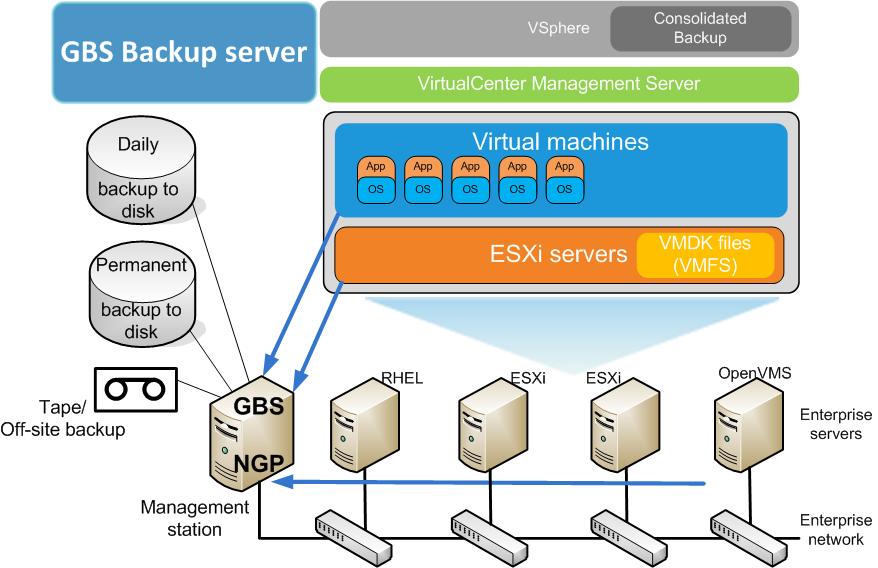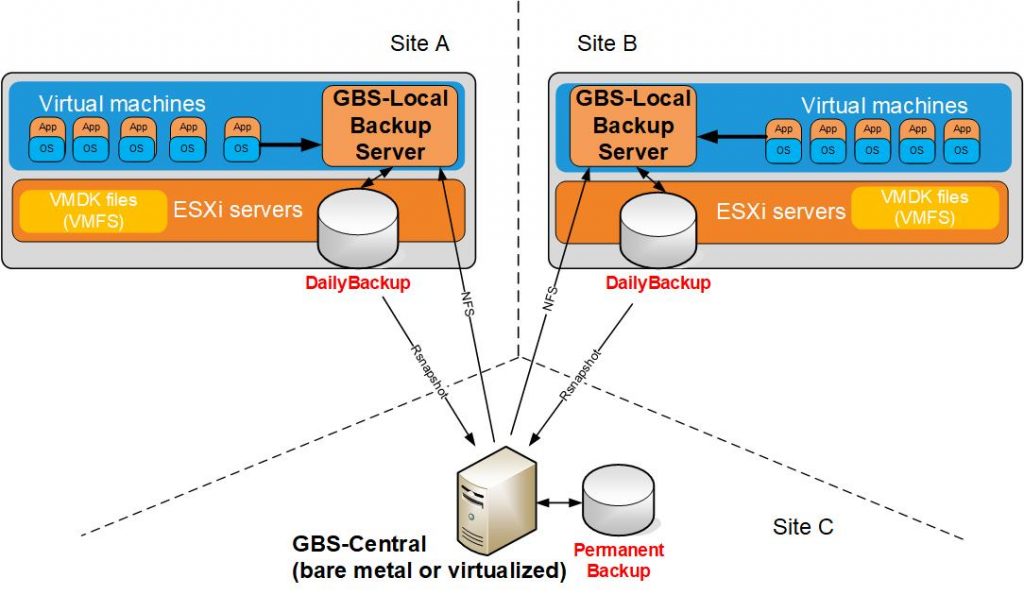Windows & MacOS
Cloud & Hybrid
Openstack Backup
Kubernetes Openshift
GBS deploys a backup server that stores all the backups in a central place, easy to find.
GBS includes several backup mechanisms, applicable for a variety of backup clients and backup sources.
Centralized backup
A GBS backup server functions as a centralized backup server, that stores the various backups in a hybrid environment into a central backup store.
Backup sources can be a variety of Linux, OpenVMS, Windows, MacOS, KVM, Kubernetes/Openshift sources, Databases and datastores.

Overnight and Permanent Backup phase
Backups are organized in an “Overnight backup” and “Permanent backup” phase.
The Overnight backup reflects the status of the last executed backup, last night, no history.
The Permanent backup saves copies of the Overnight backup and keeps a daily, weekly and monthly history.
Overnight backups are executed at nighttime during the backup window (1-6am).
Permanent backups run during daytime between two remote GBS backup servers (so this does not affect the backup clients).
As the Permanent backup depends on the network throughput between the backup servers, it may need a longer time and has all day to complete.
The permanent backup resides on a remote server, therefore the data is mirrored back to the local backup server via a network mount.
The Overnight/Permanent backups include the following mechanisms, depending on what needs to be the customer environment:
- ReaR backup for Disaster recovery purpose
- Image and file backup for various Linux distributions
- KVM backup with RSYNC or snapshots
- Backup for network equipment
- Backup of the Virtualization infrastructure (KVM hosts, VMware hosts, OpenStack nodes)
- Document management frontend for MS Windows backup.
Backup Mechanisms
Deduplication
VDO deduplication is used to detect duplicate blocks on disk
This typically saves 60-80% of diskspace
The Permanent backup only occupies a few % of the original diskspace due to VDO and hardlink deduplication
Disaster recovery
Disaster recovery is included for Linux Bare metal and Virtual Machines, using the same mechanism.
Disaster recovery can restore a Linux system in 10-20 minutes from a selected backup (Overnight backup or a Historical backup)

Cloud based
Cloud based backup can be deployed,
preferably when two or more sites are available.
Geo-redundancy in this case guarantees the backup availability in case of a site disaster.
Virtual Backup
A virtual backup server will backup the virtual environment and Virtual Machines, but also the Virtual infrastructure, network equipment and Bare metal servers.
The backups can be stored offsite via Bacula, or using a remote GBS backup server (Geo-redundancy).


Hybrid (BAre Metal)
The hybrid backup server is a hardware based backup solution, it offloads the backups outside the original application environment.
So that the backups are still available in case of a disaster in the application environment.
The hybrid backup server can also be deployed as a geo-redundant system.
Centralized backup
For Multiple sites, we offer a Centralized backup server that centralizes all the Local backups onto one central location.
This setup offers redundancy and de-duplication advantages, as all permanent backups can be deduplicated in one filesystem.

Why GBS BACKUP
GBS has a 20+ years of experience in the backup of Linux/Windows/MacOS systems
- Open Source: Licence free backup solution
- Deduplication: mechanism to deduplicate and save diskspace
- Disaster recovery: restore your system to a previous state
What You Get
A centralized off-site backup solution that starts with an analysis of the customers system.
- System Analysis:
- Remote Support: 5x8 or 24x7 SLA
- Test Lab Facilities.